|
Family: Araneidae
(orb-web spiders)
Life
> Eukaryotes
>
Opisthokonta >
Metazoa
(animals) > Bilateria > Ecdysozoa > Panarthropoda > Tritocerebra >
Arthropoda > Arachnomorpha > Cheliceriformes > Chelicerata > Euchelicerata
> Arachnida > Araneae
> Araneomorpha
In South Africa the family Araneidae includes 40 genera of
master weavers. This is one of the families referred to as the orb-web spiders
(another being, Tetragnathidae)
although some genera do not spin orb webs. The Greek myth about Arachne is
probably attributed to one of these spiders. This is one of the most diverse
groups of spiders with various shapes, colours and camouflage systems. They are
harmless to man.
There are both diurnal (day) and nocturnal (night) species.
The diurnal groups continually repair their webs, usually using them for a
number of days. The web cannot be used indefinitely as it dries and loses its
capture ability and insects will no longer stick to it. Nocturnal spiders, on
the other hand, construct a new web every night and it is taken down at dawn and
eaten. This serves as a valuable source of protein. The bridge line, the main
original stay that is built, is retained for reuse. The webs consists of a
bridge line with a frame and supporting threads, numerous radials, a viscid
(sticky) spiral and a central hub which may be open or matted with silk. Webs
may be vertical, inclined and rarely horizontal. Each species of spider has its
own characteristic web design.
The Araneidae (with the family,
Tetragnathidae) occupy a niche not
utilized by other spiders. They occupy the aerial passage amongst vegetation in
the path of flying insects. The spider sits on the web waiting for prey to get
trapped in the web. Once prey is caught, the spider then cautiously approaches
the prey, wraps it in silk to immobilize it and kills it with a venomous bite.
The prey is then moved to the centre of the web or to its retreat among
vegetation and consumed. As spiders cannot eat solids, the internal organs have
to be liquidised. The spider pumps enzymes from its mouth through the fang
puncture holes to create a soup which it can drink. This action differs from the
Tetragnathidae.
Genera indigenous to southern Africa
|
Arachnura (scorpion-tailed spiders)
The name is derived from Greek "arachne" means "spider"
and "ura" means "tail", referring to the likeness of the end of the abdomen
to a scorpions tail. One species in Africa:
Arachnura scorpionoides. |
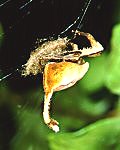 |
|
Araneus (hairy field
spiders)
Not easily separated
from Neoscona or Pararaneus. There are 16 species listed for South Africa.
The orb-web, with the hub 0.8-2.8 m above ground level,
has a diameter of 50-200mm and a free sector of 20-25% of the web. From the hub
to the spider's retreat runs a "telegraph line" that informs the spiders of any
prey caught in the web. |
|
|
Argiope (garden
spiders)
Argiope is one of the most familiar genera of orb
web spiders. Being diurnal, garden spiders are colourfully marked, the
carapace silver and the legs banded. The aposematic (warning) yellow and
black colouration of the abdomen remind birds that they are unpalatable. The
web normally has two zig-zag bands of silk called stabilimenta radiating
outwards from the hub (centre) to the bottom corners of the web. The spider
sits head down with its legs positioned in pairs, forming a cross with the
two anterior (front) pairs resting on the stabilimenta.
|
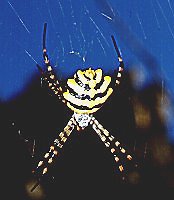
|
|
Caerostris
(bark spiders)
Bark spiders are
nocturnal orb-web spiders that construct a large orb web, up to 1.5 metres,
stretching from one tree to the next. The abdomen is
cryptically coloured and adorned with numerous horny projections and viewed from
the rear a definite animal face can be perceived. When she is off her web she
retires to a branch and packs her legs tightly next to her body and she melts
into her surroundings looking like a knot on the branch. They are large spiders
with females reaching 30mm, body length. Very few males, which are tiny, have
been collected.
|
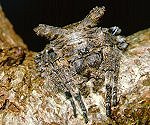 |
| Cyclosa (garbage
line spiders) A
diurnal genus with three species known from South Africa. Normally
Cyclosa can be found in its web in grass or among the branches of
bushes but also in nurseries and fences. This is a small 5-11mm spider with
an elongated abdomen ending in one to four tubercles. The vertical orb-web
measures about 150mm across and consists of many tightly woven radii and
spirals. The stabilimentum of this spider's web runs vertically or
occasionally horizontally through the hub and is decorated with the remains
of prey, the spiders exuvia and bits of debris. The numerous egg sacs are
usually incorporated into the stablimentum. At the hub the line is parted
and the spider sits hidden amongst the debris. |
 |
|
Cyrtophora
(tent-web spiders)
The only species of the genus Cyrtophora in South Africa is the
cosmopolitan tropical tent-web spider, Cyrtophora citricola.
The web of this species is a-typical, in that it is similar to mesh
curtaining, which forms the orb section of the web, and the spider
spends both day and night on it. The orb-web is supported by numerous
knock-down threads that form a tent, and these deflect prey onto the
orb-web.
|
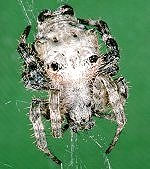 |
|
Gasteracanthus
(kite spiders)
Kite spiders are diurnal orb-web
spiders. Species occur mainly in the tropics and sub-tropics, with four
species in South Africa. The spider is small, 8-10 mm, brightly coloured
in shades of cream, yellow, red and black. The adbomen is sclerotised
(porcelain-like) with four lateral and two posterior spines, the second
pair longest and the first shortest.
|
 |
|
Gea
Closely related to
Argiope. These two genera belong to the subfamily Agriopinae. Four
species occur in Africa with
Gea infuscata
the only species found in South Africa. Not
much is known about its distribution or ecology. The orb-web is placed among
low base vegetation or grass and can be found with or without a
stabilamentaum. |
|
|
Isoxya (box
kite spiders)
Isoxya, the Box kite spiders are
small spiders, 3-7mm body length, with the typical sclerotised
(porcelain-like) abdomen of the Gastricanthinae with four lateral and two
posterior short spines. There are 6 species of these orb-web spiders found
in South Africa. |
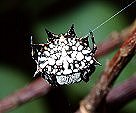
|
|
Larinia (grass orb-web spiders)
Larinia are small, 4.5-7.5mm, nocturnal spiders
and can be found in their orb-webs in long grass. The webs are constructed
at night and removed again at first light next morning. The abdomen varies
from oval to elongated, always longer than wide often marked with
longitudinal dorsal stripes or bands. Larinia can be found on all
continents, except Antarctica, with seven species in South Africa. |
|
|
Neoscona
Similar to Caerostris in being
nocturnal and cryptically coloured. It is also referred to as the hairy
field spider and has a globose (round) abdomen which overhangs the carapace.
The legs are equipped with numerous spines. During the day this spider takes
refuge amongst leaves and in or under bark. Neoscona species are very
variable in colour. This is the spider responsible for the mysterious orb
web found spanning from gutter to balustrade at night only to be missing
next morning. There are 14 species known from South Africa. |
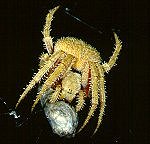 |
| Nemoscolus
(stone-web spiders) The
stoneweb spider is seldom seen as it retreats inside a small conical to
helicoid shelter positioned above the centre of its cone-shaped web, which
opens downwards onto its horizontal web. The
shelter is at the hub of the web and is pulled up and attached to some grass
or other vegitation. The common name can be somewhat missleading as the
retreat can be constructed with any available particles such as sand, plant
matter woven into silk. This retreat will also house the eggs and young.
|
|
|
Paraplectana (lady bird spider) |
|
|
Pycnacantha (hedgehog spiders)
A genus of spiders that
has an abdomen with numerous projections, hence the common name.
Pycnacantha
has, as with numerous other araneids,
abandoned life in orb-webs and hang head down with front legs outstretched
to capture flying moths.
Pycnacantha tribulus
is the only known South African
species.
Pycnacantha dinteri the only other
southern African species occurs in Namibia. |
|
Text by Norman Larsen ©. |
